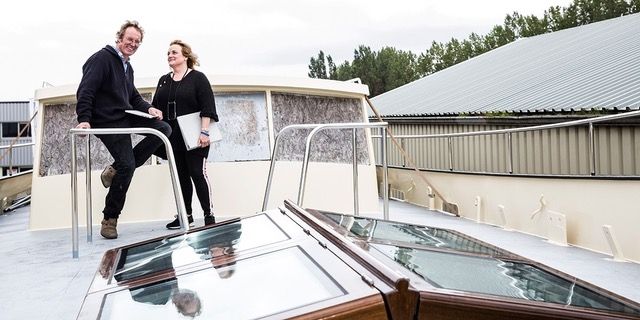Off-grid living comes a step closer
Some of the great and good are among those calling for a sustainable, independent lifestyle. Aino Grapin designs interiors for the world’s wealthy. She cites the coronavirus pandemic as her reason for speeding up the move towards off-grid living: ‘Clients can enjoy life at sea for long periods of time without having to go mix with others.’ Jeff Bezos, departing CEO of Amazon, is also said to have ordered two mega-yachts in the Netherlands, including a three-masted yacht that meets all the requirements for remaining at sea for very long periods. Vattenfall is working seriously on a gigantic water boiler powered by green electricity that will supply heat to people living in Amsterdam, Almere, and Diemen. The electrification of our vehicle fleet received a real boost with the introduction of Tesla, with Elon Musk as the product architect and the inspiration behind it. His thinking goes even beyond Earth itself, about alternative energy generation, combating global warming, and maintaining mobility. The first electric aircraft are already being used.
It’s all about energy efficiency
If you compare electric and jet-fuelled flight, around fifty times as much energy goes into a kilo of aviation fluid than into a battery. This means that the combination of long-haul flight and large numbers of passengers won’t work for electric flights for the time being. So, what is preventing all the alternatives for saving on fuel or reducing carbon emissions? It’s actually all down to energy efficiency. On this, the applications and energy carriers show significant variations. Currently, only 30% of fuel is completely used. In existing networks, as much as 40% of energy for heating is wasted because of poor insulation. Hydrogen has 85% energy efficiency. In other words, you’re dealing with multiple variables: weight, use of space, insulation, energy production and conservation, noise reduction, and the most efficient use of hydroelectric, wind and heat sources. Then there’s the fact that all of the materials must be as recyclable as possible.
Off-grid living on the H20
New Electric Marine is working on Dick Gilles’ self-sufficient sailing ship POWERHOUSE boat. Everything is designed for comfortable living and sailing with a minimum possible footprint, without having to rely on existing networks or onshore connections. At the shipyard in Middenmeer, the Netherlands, the very latest innovations in energy generation, use and storage are being applied and combined. The results include hybrid propulsion and a large pack of lithium batteries that charge in 2 to 3 hours for 2 to 3 weeks of power supply. The solar panels have been developed in-house, ensuring exceptionally high efficiency on a small surface, while also having the practical advantage that you can walk on them. Repairing or replacing something at sea is never easy, so it helps if the panels can take a beating. We now estimate its lifespan to be 25 years. All in all, the POWERHOUSE boat is a strong and robust vessel. Featuring hybrid propulsion, it’s built to navigate the world’s oceans safely.
The capacity of the technologies applied – in terms of energy efficiency and increased power – changes on a daily basis. At New Electric Marine, we offer value-for-money bespoke solutions for all types of electric or hybrid marine applications. For the latest developments, keep an eye on our website or contact us for an obligation-free appointment.



